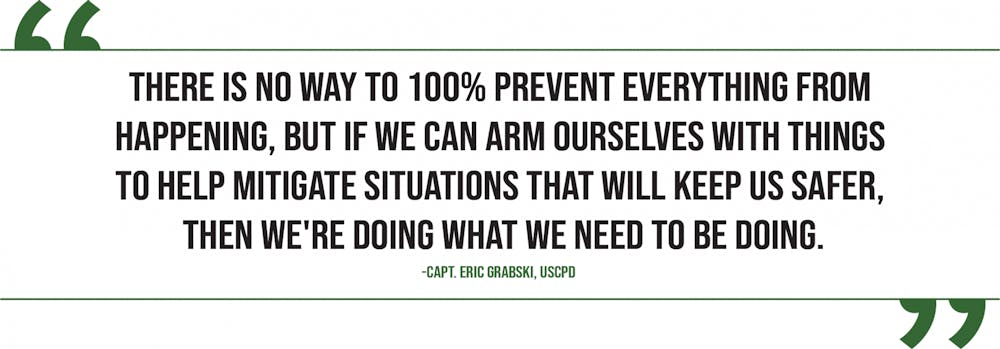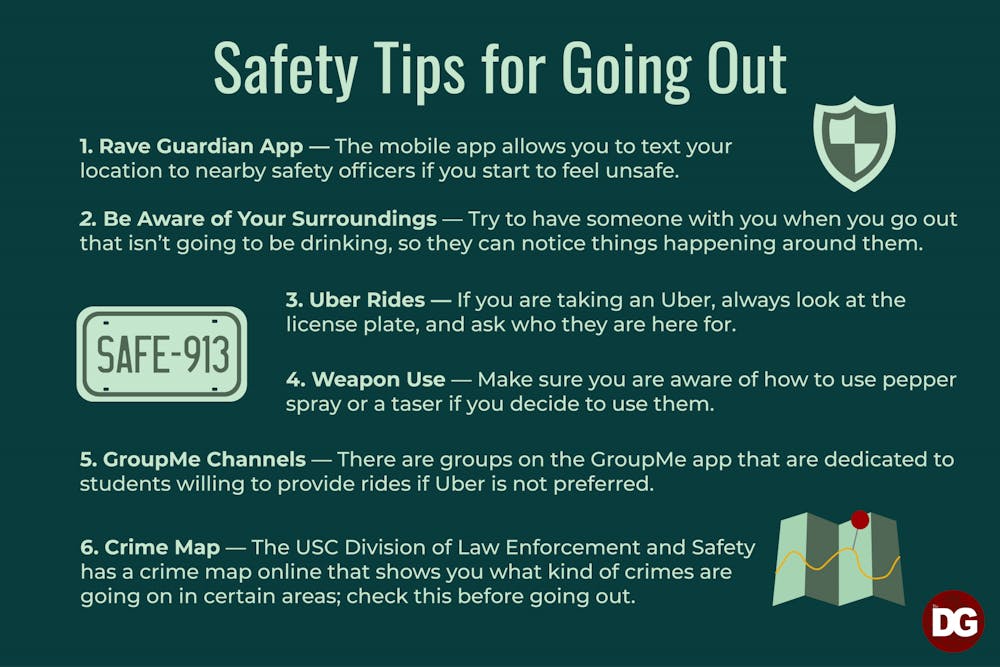Students need to have fun during their time in college, which for many includes going out, but it is important to do it in the safest way possible by planning, arranging for rides and carrying some form of physical protection.
In 2019, 18.7 crimes per 10,000 full-time students were reported on college campuses. Of the 27,300 crimes reported, 43% were forcible sex crimes, 8% were aggravated assaults and 3% were robberies.
After recent tragic events near college campus, such as the quadruple murder in Moscow, Idaho last year, some students are choosing not to go out as they fear for their safety. But shying away from fun experiences during college is not necessarily the answer.
USCPD Capt. Eric Grabski encouraged downloading the Rave Guardian app, which any student can use to anonymously text a nearby dispatcher if they are feeling unsafe. Grabski said that students should not be afraid to report anything that is bothering them. Even if the vibe just seems off, go with your instinct.
When going out, always have a plan in place and have bystander accountability with your group. Before you leave home, know who you’re going out with, what you’re going to do while out and how you’re going to get home. If you plan on drinking, have someone there that is committed to staying sober to keep their guard up. When you are highly intoxicated, you are the most vulnerable and an easy target, Grabski said.
USCPD has also expanded call boxes beyond campus and into other areas of Columbia, including Five Points. Grabski said the boxes serve the dual purpose of keeping patrons safer while deterring criminals from the area.
"If you have an environment where the opportunity may not be there or might be more of a harder target, then more than likely there's not going to be some time of criminal activity there," Grabski said.
There are several group chats on campus if Ubers are not your preferred mode of transportation for a night out, including girls-only groups, which can make you feel safer if you’re feeling uneasy about a ride service with strangers.
These groups make finding a ride easier while decreasing potential incidents, and it may be easier to trust a peer than a stranger.
If you do decide to carry a form of protection, know how to use it and don’t let the first time be the time when you need it most. Whether it is pepper spray, a taser, knuckle weapons or other forms of defense, know what you’re doing before you decide to bring it out.
The USC Division of Law and Safety maintains a crime map resource that you can use to better understand the areas around campus and their crime rates. Grabski emphasized the importance of students developing an understanding of safety resources now and taking it with them as they graduate. Crime maps like these aren’t only beneficial for deciding where to go for the night, but also when you are searching for a place to live after you graduate.
“There is no way to 100% prevent everything from happening," Grabski said. "But if we can arm ourselves with things to help mitigate situations that will keep us safer, then we're doing what we need to be doing.”

The USC Division of Law and Safety worked hand-in-hand with the university president and Uber when USC student Samantha Josephson was murdered after being abducted in Five Points in 2019. Josephson, a 21-year-old USC student at the time, misidentified another car as her Uber during a night out with friends and was killed by the driver of the vehicle.
The "What's My Name?" campaign was then created by the university and Uber to build awareness for students to check their ride's description and ask for the name on their Uber account. During the emergence of the campaign, former unvieristy President Harris Pastides encouraged students to refuse any ride service or driver that could not easily relay that information.
While it is so important for students to be safe, it is equally important for them to grow, have fun and learn from their mistakes. However, you should always be aware of the safety resources that the campus has available, plan your ride home, know what to do in a potentially harmful situation and stay close to your group.
“If you don’t do anything, do have a plan and do know what resources there are," Grabski said.

